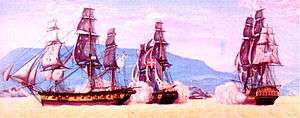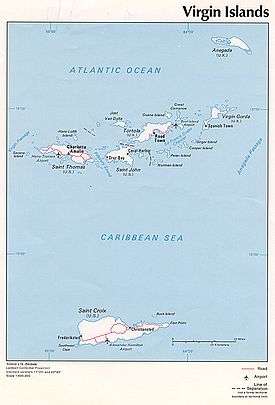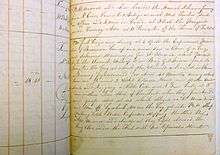HDMS Lougen (1791)
The first Lougen[1] was a brig of 18 guns, launched in 1791 [2]. She was the first Danish warship to be copper-sheathed[3] She was active protecting Danish merchant shipping and suppressing pirates in the Mediterranean and in the Caribbean. In March 1801, she fought off the British privateer Experiment and the 22-gun warship HMS Arab in a single action.[Note 1] When the British captured the Danish West Indies in 1801, Lougen was part of the booty. The British later returned her to Denmark where she was broken up in 1802.
 Lougen (centre) at the battle of West Kay in combat with Experiment and Arab | |
| History | |
|---|---|
| Name: | Lougen |
| Builder: | Stibolt of Nyholm, Copenhagen |
| Launched: | 10 September 1791 |
| Commissioned: | 1792 |
| Out of service: | In dock during 1793, 1794, 1797 and 1800 |
| Fate: | Broken up 1802 |
| Notes: |
|
| General characteristics | |
| Class and type: | Lougen-class brig-of-war |
| Displacement: | 169½ tons |
| Length: | 93 ft 6 in (28.50 m) |
| Beam: | 26 ft (7.9 m) |
| Draught: |
|
| Sail plan: | Brig |
| Complement: | 85 men |
| Armament: | 18 × 18-pounder short cannon |
Service record
- April 1793 – October 1794: Danish West Indies.
- 1795–96: Danish home waters (Elbe and West Jutland) under the command of Captain Johan Hartvig Ernst von Berger.
- 1797–99: Mediterranean, in company with HDMS Thetis but not before the Battle of Tripoli (16 May 1797). The squadron of three frigates and two brigs had the duty of protecting Danish shipping from interference by the Bey of Tripoli.
- 1800–01: Danish West Indies.[Note 2]
On 1 September 1800, Lougen came to the rescue of the schooner Den Aarvaagne,[Note 3] when the latter was under attack by the British privateer Dreadnought. On Lougen's approach, the privateer broke off the action.
Later in 1800, Lougen captured the privateer Eagle and brought the captured schooner into St Thomas[2].
Battle of West Kay


On 3 March 1801, as rumours of a diplomatic rift between Britain and Second League of Armed Neutrality were first reaching the Danish West Indies, and a full month before the first Battle of Copenhagen, Lougen met and fought with HMS Arab and the privateer Experiment off West Kay, St Thomas. The two British ships approached the brig Lougen, under the command of Captain Carl Wilhelm Jessen, and the schooner Den Aarvaagne. Arab, commanded by Captain John Perkins, approached the two Danish vessels and, according to Danish accounts, without warning, fired several broadsides at Lougen before the Danish ship was able to return fire. Lougen, which had escaped serious damage, began to return fire steadily. Experiment initially attempted to capture Den Aarvaagne, but Den Aarvaagne obeyed orders to stay out of the fight and instead escaped south to Christiansted on St Croix with its intelligence on British actions. Experiment then joined Arab in the attack on Lougen, with the two British ships sandwiching the Danish ship. During the engagement, which lasted for over an hour, one of Lougen's shots struck the Arab's cathead and loosed the bower anchor. (Perkin's reported that it was the first shot from Lougen that loosed the bower anchor.) Arab's crew was unable to cut the anchor free, leaving Arab unable to manoeuvre effectively. This allowed Jessen to steer a course that brought Lougen under the protection of the shore batteries and then into St Thomas. The Danish government awarded Captain Jessen a presentation sword made of gold, a medal and 400 rixdollars (the equivalent of a whole year's salary for a captain in the Danish Navy) for his actions.[4]
Fate
British naval and military activity in the area could not be countered. British forces took Lougen as a prize when they occupied the Danish West Indies in March. One year later, in 1802, the British returned Lougen to Denmark when peace was restored. The Danes later decommissioned the brig and she was broken up.
Notes
- Arab was commanded by John Perkins, the first black commissioned officer in the Royal Navy.
- Carl Wilhelm Jessen was 1st officer of Lougen during the 1793–94 service, and captain in 1800–01. After the Napoleonic Wars he continued his close association with the Danish West Indies as commandant and later governor of St Thomas, He was promoted rear admiral on his retirement from the Navy on 9 June 1822. He died on 30 March 1823 and was buried on St Thomas. In 1901 his body was transferred to the Naval Church på Holmen in Copenhagen.
- The name Den Aarvaagne translates as "Alert" or "The Watchman".
References
- Danish Naval Museum with design plans
- Balsved - Lougen
- Record Card for Lougen No.1
- Balsved - Battle of West Kay
- (in Danish) The Danish Naval Museum is building a new website at which many details, drawings and models may be available. The English-language version of this website is still under construction (March 2016)
- Balsved's Danish Naval History website